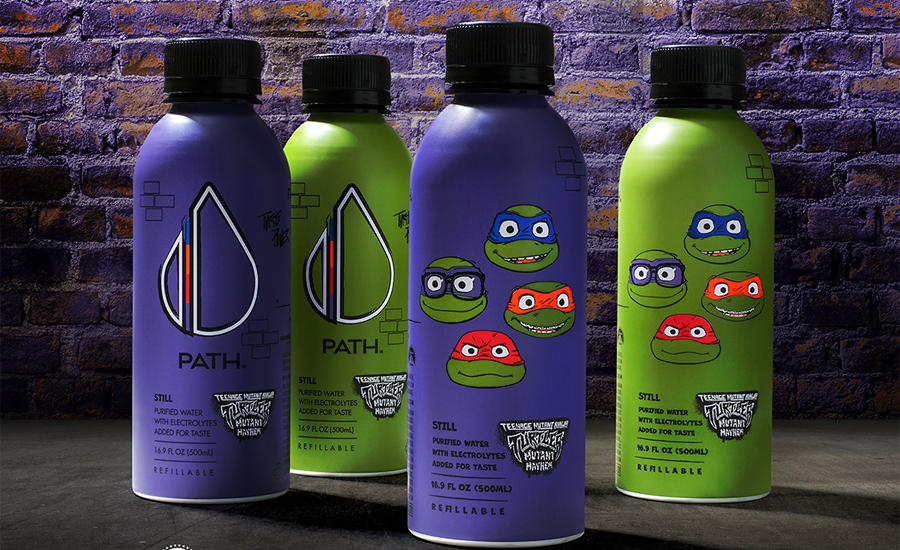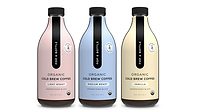Bottled water sees growth, category expands on consumer trends
Premium, sparkling waters bring opportunity to reach consumers

Image courtesy of Gatorade
Regarded as one of the greatest current basketball players, Golden State Warriors Stephen Curry recorded 32 points, six rebounds, and seven assists in the 123–107 win over the Boston Celtics on Dec. 10, 2022 — a rematch of the 2022 NBA Finals. As the second oldest player in NBA history to record at least 30 points in a game, Curry is quoted for saying: “Drinking water is essential to a healthy lifestyle.”
Although most consumers consider drinking water as key to living healthily, experts note that the bottled water market has slowed due to price increases.
Sally Lyons Wyatt, executive vice president and practice leader at Chicago-based Circana, points to both dollar and volume growth for bottled water as having slowed in the past year.
“Consumers’ quest for enhanced health and well-being includes hydration, which bodes well for bottled water,” she says. “However, as prices continued increasing, consumers started to pull back and invest in less expensive options including water filtration options and adding functional benefits through beverage mixes.
“[The] latest 52 weeks ending Aug. 13 shows dollar sales up 7.9% with volume sales declining 1.7%, due in part to consumers reacting to continued price increases,” Lyons Wyatt continues. “Overall bottled water pricing is up 9.8% on a dollar/volume basis in the last 52 weeks.”
Michael Bellas, chairman and CEO of Beverage Marketing Corporation (BMC), Wintersville, Ohio, echoes similar sentiments, noting that volume has been soft while revenues continue to increase as impacted by inflation.
“However, pricing has also begun to slow in the second half of the year,” Bellas says. “Despite price increases, bottled water remains the best value refreshment beverage on the market. Health and wellness is still the key driver for the category.”
Consumer demand brings challenges, opportunities
Although the bottled water market continues to benefit from consumer interest in health and wellness, experts note that consumer trends are impacting the category.
“During the pandemic, decreased mobility — with an associated increase in stay-at-home bottled water consumption — and concerns about tap water quality helped drive penetration growth,” Circana’s Lyons Wyatt explains. “Over the past year, however, household penetration has dropped due to several factors including higher prices, other hydration options, etc.
“In fact, consumers’ hydration universe has broadened,” she continues. “Not only the traditional beverages, but also electrolyte mixes, etc., are contributing to the headwinds for the category.”
BMC’s Bellas notes that, although consumer demand for variety has spurred innovations in the realm of specialty and enhanced waters, these segments only represent a small share of the overall market.
“Specialty waters are still popular with today’s consumers but volume performance has been soft in 2023,” Bellas says.
Circana’s Lyons Wyatt points to enhanced bottled waters’ performance as stable, as many consumers seek out alternatives to sugary drinks.
“About a quarter of bottled water volume is enhanced in some way — including alkaline, etc. — which has remained pretty steady in the past two years, and is a testament to consumers seeking more than hydration or a fortified boost to ‘normal’ water and an alternative to sugary sports drinks, etc.,” she explains.
To help meet consumers’ growing need states, Gatorade, a brand of PepsiCo, Purchase, N.Y., announced it will enter the bottled water category with the introduction of Gatorade Water, the brands’ first unflavored, electrolyte-infused water, set to hit shelves in Q1 2024. A premium water, Gatorade Water will be available in 1-liter, 700-ml sport cap and 700-ml six-pack formats, the company says. All bottles are made from 100% recycled plastic, it notes.
“Today’s athletes and active people are looking for solutions not only in the heat of performance, but also throughout their full day. Gatorade Water is a direct result of this consumer need,” said Emily Boido, senior director of marketing at Gatorade, in a statement. “With the launch of Gatorade Water, we’re bringing active people an unflavored alkaline water option that is electrolyte-infused for a refreshing and crisp taste and is from a brand they trust.”
Caleb Bryant, associate director of food and drink at Mintel, Chicago, considers premium bottled water, such as alkaline water and highly sustainable bottled water, as representing a growing segment of the total water market.
“Consumers purchase waters that reflect their aspirations, image, and to communicate their status,” Bryant says. “Seventy-two percent of consumers aged 18-34 earning $75,000 and up agree that premium bottled water can act as a status symbol.”
In a recent Mintel report, titled “US Still and Sparkling Waters Market Report 2023, the market research firm highlights how sustainability and luxury attributes in bottled waters overlap among athletes.
“Self-identified athletes under index as bottled water consumers,” it states. “Yet, those who do drink bottled water strongly over index as purchasers of premium and sustainable bottled water brands. Athletes are also significantly more likely to agree that premium bottled water acts as a status symbol and that it is worth paying more for environmentally friendly bottled water.”
|
|
DOLLAR SALES | % CHANGE vs PRIOR YEAR | MARKET SHARE | % CHANGE vs PRIOR YEAR | |
| Nonflavored Convenience/Bottled Still Water
|
$15,453,471,492 | 9 | 62 | 0.6 | |
| Flavored Seltzer/Sparkling Mineral | $3,817,729,345 | 3.3 | 15.3 | -0.7 | |
| Flavored Convenience/Bottled Still Water | $2,379,706,088 | 1.1 | 9.6 | -0.6 | |
| Nonflavored Jug/Bulk Still Water | $2,301,319,807 | 12.8 | 9.2 | 0.4 | |
| Nonflavored Seltzer/Sparkling Mineral | $961,303,956 | 16.6 | 3.9 | 0.3 | |
|
|
Total Sales* | $24,913,530,688 | 7.9 | 100 | --- |
*Includes brands not listed
Source: Circana, Chicago. Total U.S. Multi-outlet w/C-Store, grocery, drug, mass market, convenience, military, select club and dollar retailers for the 52 weeks ending Aug. 13, 2023
Keeping up with market trends
Although rising economic uncertainty is impacting the bottled water category, experts point to market trends that can bring advantages to beverage-makers.
In highlighting industry trends, the Mintel “US Still and Sparkling Water” report points to premium/luxury water as a robust growing segment of the total water market despite the current economic climate.
“Luxury product sales are booming across categories and consumer interest in small luxurious experiences may translate to increased sales of premium water,” the report states.
Further, as sparkling water can serve as an alcohol alternative, the report points to premium sparkling water as having consumer appeal.
“Consumers are rethinking their relationship with alcohol, offering new opportunities for sparkling water brands to directly target alcohol consumption occasions” it states. “Thirty-eight percent of consumers closely or occasionally follow a sober-curious lifestyle and 28% of sober-curious consumers drink sparkling water as an alcohol alternative.
“Sparkling waters that feature unique flavors with premium packaging design act as appealing alternatives to alcoholic beverages,” the report continues.
Where packaging designs appeal to consumers’ proclivities, Circanca’s Lyons Wyatt points to brands including sustainable elements on bottled water to help boost sales for brands.
“Sustainability elements such as sourcing (domestic versus imported) and carbon footprints are starting to appear both on packaging and in consumer messaging and should help in bolstering sales,” Lyons Wyatt says.
However, when it comes to sustainable package types, such as premium glass and aluminum cans, Lyons Wyatt notes that the share these packages account for within the bottled water category remains relatively small.
“While the relatively more premium glass, can, and aluminum bottle formats contribute to the importance of non-plastic package types in dollar terms, their relative size is still small, and its share of bottled water remains flat,” she explains. “Sparkling entrants in the past few years piggy-backed on the trend toward aluminum cans seen in smaller beer brands.
“At the same time, bottled water manufacturers have started to transition some of their still water plastic bottles to rPET (recycled plastic) and call it out on labels,” Lyon Wyatt continues. “This may provide consumers who want to stick with plastic bottles a ‘pass’ on making the choice to opt for another format. Likewise, some of the premium entrants in sustainable packaging may represent ‘affordable luxuries’ across the economic spectrum.”

Image courtesy of PATH
In keeping with sustainability trends, Fremont, Calif.-based PATH announced the launch of two limited-edition Teenage Mutant Ninja Turtles: Mutant Mayhem bottles in partnership with Paramount Consumer Products. The launch celebrates the new feature film from Paramount Pictures, Nickelodeon Movies and Point Grey, “Teenage Mutant Ninja Turtles: Mutant Mayhem,” the company notes. The 16.9-ounce aluminum bottles are BPA free and contain ultra-purified still water with added electrolytes and a balanced 7.5 pH, it says. Each bottle is 100% recyclable and refillable, available exclusively at Target stores nationwide and on Target.com.
“In response to rising consumer demand for sustainable solutions, we’re proud to partner with like-minded brands to create innovative products that reflect cultural trends,” said PATH’s Co-Founder and CEO, Shadi Bakour, in a statement. “With Paramount Pictures and Nickelodeon Movies’ ‘Teenage Mutant Ninja Turtles: Mutant Mayhem’ joining forces with PATH, we’re witnessing an exciting convergence of pop culture and environmental responsibility.”
Mintel’s Bryant points to personal refillable water bottles as trending upward, however, he notes that the majority of bottled water purchasers still keep bottled water stocked-up at home.
“Sustainability is a hot topic within the bottled water category and many younger consumers opt for using personal refillable water bottles rather than purchase bottled water,” Bryant explains. “Sixty percent of refillable water bottle users say that buying bottled water is only worth it when their refillable water bottle isn’t available. However, bottled water purchasers tend to be category loyalists, 73% of consumers say they always keep bottled water stocked at home.”
Bottled water at its essence
As still water holds the lion’s share of the total bottled water market, experts highlight how the home and office delivery (HOD) of water presents opportunities for the category.
“HOD is the star performing bottled water segment in 2023,” BMC’s Bellas says. “Growth is continuing for the home business and commercial is also seeing growth.
“In addition to traditional HOD, we’re seeing strong growth in 5-gallon water sold at retail along with the 5-gallon exchange business,” he continues.
Circana’s Lyons Wyatt points to HOD and online bottled sales as a convenient way to replace tap water.
“Home delivery presents an opportunity for consumers who have migrated to a more remote working environment to benefit from the option of buying either large format (e.g., 5-gallon jug) and/or having a more convenient purchase experience (i.e., not having to lug a heavy case pack of water home),” she explains. “While still small, purely online bottled water sales represent only about 2% in dollar terms, with the weight of water imposing shipping cost complications into that aspect of the category’s supply chain, and helping drive continued interest in curb-side fulfillment and continued strength in large format retail chains.
Mintel’s Bryant notes that, no matter how bottled water is delivered, category sales remain strong.
“Total bottled water sales (both unflavored and flavored) reached an estimated $20 billion in 2022, up 14.6% from 2021,” he says. “Still water represents 81% of the total packaged water market.”
Noting that the packaged water market continues to benefit from consumer interest in health and wellness, Bryant points out that “83% of consumers say that staying hydrated is one of their most important health goals.”
Looking for a reprint of this article?
From high-res PDFs to custom plaques, order your copy today!






